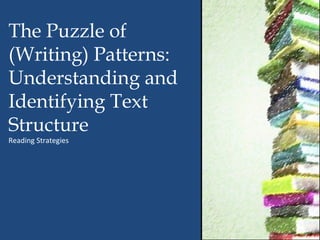
Understanding and identifying text structure 1
- 1. The Puzzle of (Writing) Patterns: Understanding and Identifying Text Structure Reading Strategies
- 2. MMAAPPPPSS • Asking “Where is the proof?” leads you to the author’s supporting details. • Supporting details give support – evidence or proof – for the author’s point. TTHHEE QQUUEESSTTIIOONNSS WWEE KKNNOOWW NNOOWW TTOO AASSKK……
- 3. • Or the TEXT STRUCTURE… Identifying Understandin g The Puzzle of Patterns Text Structure
- 4. A “structure” is a building or framework. “Text structure” refers to how a piece of text is built.
- 6. There are patterns or clues available for every text.
- 7. • The major supporting details of a paragraph are often organized in a certain pattern. • At times, you can forecast the pattern of organization when you read the topic sentence • After you make a question out of the topic sentence, you can mentally prepare a structure in which to fill in the answers.
- 10. • What kinds are there? • Signal words (transitions):
- 12. • How are these alike? • Signal words (transitions): the same, identical similar, similarly, similarity alike, like, likewise both not only . . . But also
- 13. • How are these different? • Signal words (transitions): differs from, differs by, a difference contrasts with, in contrast, to the contrary on the one hand . . . on the other hand however, although, but, while instead, rather distinguishes, distinguish between
- 14. ItIteemm 1 1 SSimimilialarritityy o orr d dififffeerreennccee SSimimilialarritityy o orr d dififffeerreennccee ItIteemm 2 2 SSimimilialarritityy o orr d dififffeerreennccee SSimimilialarritityy o orr d dififffeerreennccee
- 15. • What does this word or idea mean? • Signal words (transitions): is, that is is called, can be understood as, refers to means, has come to mean defined as consists of is not; rejected the idea (used to show what a term does not mean)
- 16. Term Being Defined General Category Specific Type Particular Example
- 17. • Details to help understand the general statements • Signal words (transitions): for instance, to illustrate, namely, for example.
- 18. GGeenneerraall ccaatteeggoorryy SSppeecciiffiicc eexxaammppllee SSppeecciiffiicc eexxaammppllee SSppeecciiffiicc eexxaammppllee
- 19. • What made this happen? • Signal words (transitions):
- 20. • What does this lead to? What is the result of this action? • Signal words (transitions):
- 21. CCaauussee CCaauussee CCaauussee EEffffeecctt CCaauussee EEffffeecctt EEffffeecctt Effect, which becomes Effect, which becomes CCaauussee Effect, Effect, which becomes a cause a cause which becomes a cause a cause EEffffeecctt
- 22. • When did events happen? • Signal words (transitions): before, during, after first, second, third next, then, later preceding, following, afterward as soon as, when, while, until, since days, dates, and times
- 24. • What order the steps occurred • Signal words (transitions): first step, second step, third step first stage, second stage . . . first, next, eventually, last start, continue, end any of the words from the Narration List in your textbook.
- 25. Second event Second event First event First event Third event Third event Fourth event Fourth event and so on and so on
- 26. • Where are things located? • Signal words (transitions): on the left, in the middle, on the right in front of, in back of above, below, underneath, behind, forward off in the distance, beyond, up close, near, far at, in, on (at the store, in the wilderness, on the table) inside, outside, inward, outward ten feet away, a mile in the distance, 2 ½ inches from the top.
- 27. • As you read, mentally use your senses, especially your sense of sight, to re-create the scene the author is describing. • Sometimes it’s helpful to draw a diagram or map